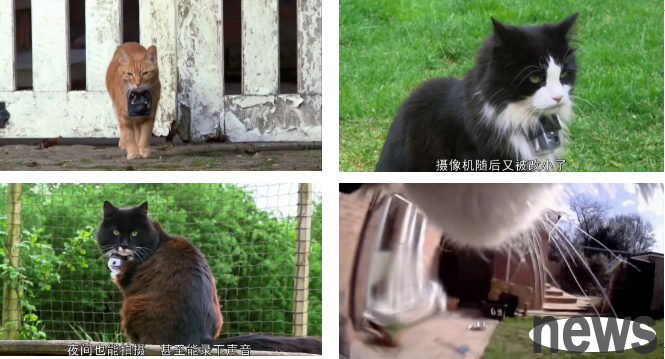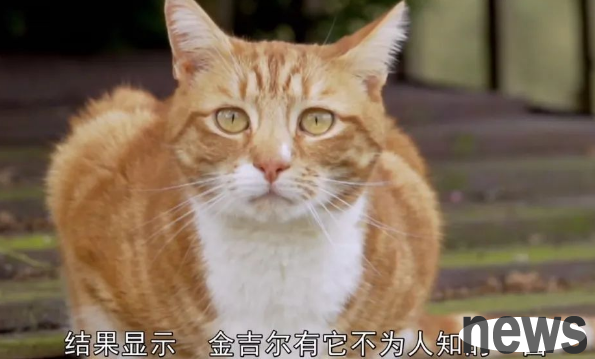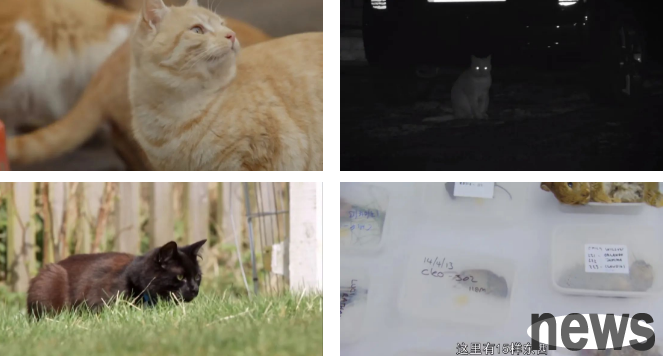What does a cat look like in our eyes?
is gentle and cute, obedient, furry when caressed, and can be snuggled in your arms. There are about 10 million cats in the UK, most of which are gathered in the southeast. The British BBC has a documentary called "The Secret Life of the Cats".
John Brad and Sha La Alice are two British cat scientists. After finding a village where cats gather and are suitable for observation, they recorded the life of 50 cats in the village for a week.
And the age, size and breed of these 50 cats are different. Scientists use cameras, cat cameras, and GPS locators to monitor the cat's trip 24 hours a day.
In this village, there are large lawns in public areas, many small gardens, hedges, farms and woods nearby, and cat holes are on the doors of almost every household.
In our eyes, where will cats go after leaving their cat holes?
Preat? play? Just find a lawn alone.

In order to record the natural and real life videos of cats, wildlife tracking expert Alan Wilson designed a collar that is smaller, lighter than wildlife collars, and has a battery life of 24 hours.
With cat tracker, researchers can observe the daily trajectory of cats. Some are long and have active repetitive behaviors, some are concentrated and dense, and have been wandering around the home, some are going to farther forests, some are destinations in the back garden of neighbors, etc. It was observed that each cat has different whereabouts and has its own specific activity area.
They usually go out at night, go home during the day, and go to the back garden? forest? Or a public area?
Scientists also gave a word called range of activity. Situ, who lives next to the village, has a large range of movement, about three hectares, and can walk two miles a day, which has a lot to do with the fact that it was a farm cat before.
The range of cats in the center of the village is more obvious. The male cats are about one hundred meters away from home, and the female cats are only half of the range of movement. Cats living in high cat density, their travel ranges are very similar to each other. Most cats will patrol and wander not far from the cat's cave, and the back garden is their favorite.
To further research, scientists selected 14 cats and wore new cameras designed by Dr. Alice Sara and Alya Sheikh, which not only shoot at night, but also record their sounds. The new cameras and GPS locators can observe where they are and what they see from the world in the eyes of the cats.

So what are the cats who are not patrolling in the back garden?
Most cats in the village are moving near cat caves, so it is easy to become a arena on gravel paths, hedges, and gardens. As the saying goes, "If a cat violates a cat, a cat will violate a cat." Cats also have their own sense of territory, and their territory is smaller than the range of activities.

Gingir's owners think their cats may tease birds, sleep, sleep, or sunbathe in the sun.
Through the photos, Jinjill really looks relaxed and calm.
However, through the trajectory map, scientists found that in fact, Jinjier's itinerary was like this - after leaving the cat's hole after dinner, they first inspected their own back garden, then went to the public areas of the village, and then deliberately teased other cats in other people's back gardens, "Cats should not look like they are!"
When Jinjill met other cats on patrol, both sides would hiss, growl, and roar to keep their distance and start running to avoid confrontation. Scientists observed that many of these 50 cats rarely fight, but often confrontation to avoid confrontation. Jinjill's itinerary is patrol ➕confrontation.
Scientists also raised the question of how they divide crowded territory; how they divide time to avoid fronts; why they reduce hunting; what impact do we have on cat behavior shaping.
50 cats must not avoid overlapping in the village's range of activities. So will there be fights in overlapping activity areas? In fact, cats like to have their own territory space. In order to protect their territory, they will try to avoid being injured as much as possible.
The resident of a family was curious why Kate and Phoebe often quarreled and had a bad relationship. Through observing and tracking the trajectory, they found that their activity areas often overlap, but the magic is that Kate often goes out at night and occasionally comes out during the day; Phoebe's activity time is after lunch during the day, which is one at home and the other outside, just like a shift system, they tacitly avoid the confrontation, but if Kate goes out during the day, he may meet Phoebe, and the confrontation the cat owner sees will appear.
Then the overlapping feature of the cat activity areas in the village is that they share the same area at different times. How are
shifts implemented?
Observation found that cats secrete chemical signals and odors by rubbing their faces/claws, that is, leave a mark for cats passing by, telling them when and where they came here. Through the mark, cats can detect that several cats have visited here, which will also reduce the occurrence of confrontation.
The data observes that the average time the cat leaves the cat's hole is 20%, which means that most cats choose to be at home and think that they are more free at home. In the past, humans were prone to mice suffering from grazing, and mouse poison and sticky rat plates were not useful. Raising cats could be cleaned up. On the same farm, we had to provide food for cats. David Hicks raised many cats on the cattle farm for three or four years.

So is the wildness of regional cats still there?
In a week, researchers collected "hunting trophys" sent by cat owners. On average, one cat had half a trophy in about a week..
By observing the daily trajectory of Kowkow, potato chips, and Claude, they found that they would visit Luo Xi's home. An hour after Luo Xi finished her meal at home, Claude appeared at Luo Xi's house and began to steal food without restraint. The next afternoon, he visited him and ate again.
Surprisingly, other cats also eat each other's food, and eating each other reduces the cat's hunting wildness. We have changed the environment, and cats' habits have changed accordingly. The food is rich in nutrition, so they do not need to hunt.
The reduction in wildness of many cats has once again confirmed that there are six cats in Edward's family who are not related to blood. Most of them go out together, play together, and walk slowly together, and no one will run very fast.
The editor wants to say that this documentary makes us realize that cats are changing socially, more like pets and more like friends, they will patrol and guard their owners’ small homes. Once a domestic cat is abandoned, it will be difficult for cats that have lost their wildness to survive. Maybe one day you will encounter stray cats on the road with open lids on the lid.
